The Particle Board Market is estimated to be valued at USD 28.3 billion in 2025 and is projected to reach USD 48.3 billion by 2035, registering a compound annual growth rate (CAGR) of 5.5% over the forecast period.
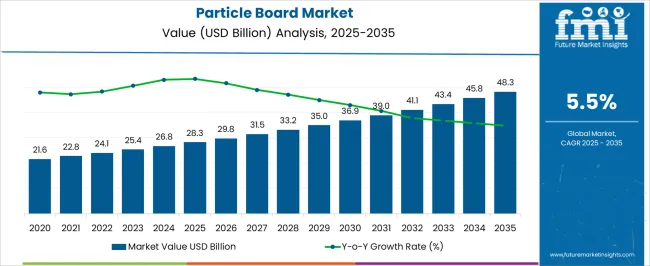
| Metric | Value |
|---|---|
| Particle Board Market Estimated Value in (2025 E) | USD 28.3 billion |
| Particle Board Market Forecast Value in (2035 F) | USD 48.3 billion |
| Forecast CAGR (2025 to 2035) | 5.5% |
The Particle Board market is experiencing steady growth driven by the increasing adoption of engineered wood products in furniture manufacturing, interior construction, and residential applications. The current market landscape is shaped by rising demand for cost-effective, sustainable, and lightweight materials that provide structural stability without the higher costs associated with solid wood.
Growth has been supported by the availability of raw materials such as sawdust, wood chips, and agricultural residues, which not only reduce production costs but also promote environmentally friendly practices. The market outlook is further strengthened by rising urbanization, increased residential construction, and a growing preference for modular and ready-to-assemble furniture.
Continuous innovation in adhesives and bonding technologies has improved the durability and performance of particle boards, enabling their wider application across various end-use sectors As consumers increasingly seek sustainable and functional interior solutions, particle board is expected to remain a key material choice, with long-term growth opportunities driven by both supply chain efficiencies and evolving design trends.
The particle board market is segmented by raw material, application, end use, and geographic regions. By raw material, particle board market is divided into Sawdust, Shavings, Flakes, Excelsior, and Chip. In terms of application, particle board market is classified into Furniture and Construction. Based on end use, particle board market is segmented into Residential, Commercial, and Industrial. Regionally, the particle board industry is classified into North America, Latin America, Western Europe, Eastern Europe, Balkan & Baltic Countries, Russia & Belarus, Central Asia, East Asia, South Asia & Pacific, and the Middle East & Africa.
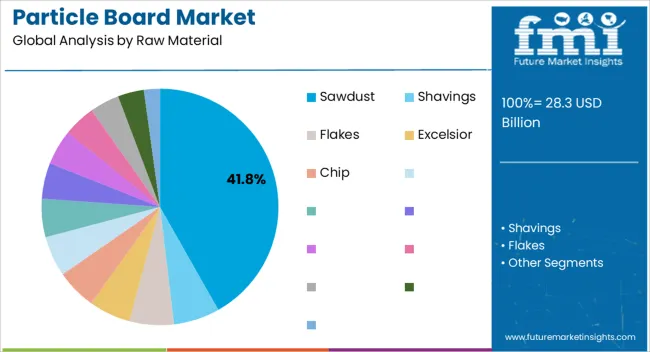
The sawdust raw material segment is projected to account for 41.80% of the Particle Board market revenue in 2025, making it the leading raw material. This dominance is being attributed to its abundant availability as a byproduct of timber processing, which allows manufacturers to produce particle boards at lower cost while supporting sustainable manufacturing practices.
The growth of this segment has been reinforced by increasing environmental regulations and a focus on reducing wood waste, which has encouraged the use of sawdust in engineered wood products. Sawdust provides consistent particle size and moisture content, improving the structural integrity and surface finish of particle boards.
Additionally, the flexibility to combine sawdust with various adhesives enhances the quality of finished products, meeting the performance requirements of furniture and construction applications The segment’s market position is expected to be maintained as manufacturers continue to optimize production techniques and respond to growing demand for eco-friendly materials.
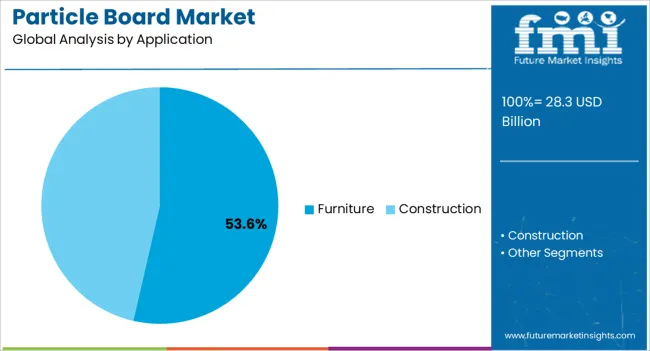
The furniture application segment is expected to capture 53.60% of the Particle Board market revenue in 2025, making it the leading application area. The dominance of this segment is being driven by the increasing demand for affordable, durable, and aesthetically versatile furniture in both residential and commercial spaces.
Furniture manufacturers favor particle boards due to their lightweight nature, ease of machining, and compatibility with laminates and veneers that enhance appearance without significant cost increases. The segment has benefited from rising urbanization, the popularity of modular and ready-to-assemble furniture, and growing consumer awareness of sustainable materials.
Moreover, the ability of particle boards to provide structural stability and uniformity in panels supports complex furniture designs and large-scale production The market growth in this segment is expected to continue as consumer preference shifts toward functional, eco-friendly, and cost-efficient furniture solutions, supporting the long-term demand for particle board in the furniture industry.
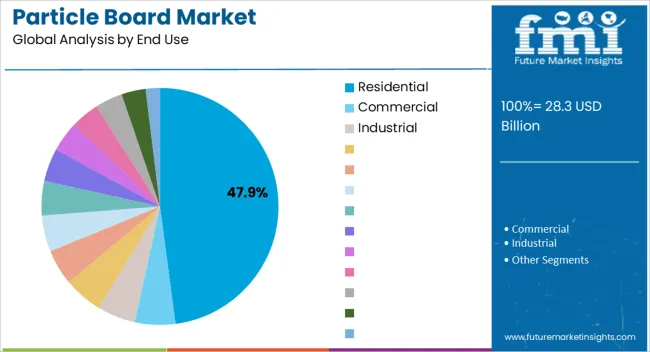
The residential end-use segment is projected to hold 47.90% of the Particle Board market revenue in 2025, establishing it as the largest end-use industry. This leading share is being driven by the growing demand for interior furnishings, cabinetry, shelving, and storage solutions in urban housing and apartment developments.
Residential construction projects increasingly rely on particle board due to its cost-effectiveness, lightweight properties, and ability to deliver a consistent finish for furniture and paneling applications. The segment’s growth is reinforced by the rising preference for sustainable and recycled materials in home interiors, which aligns with the environmental objectives of both consumers and manufacturers.
Particle board’s adaptability allows it to meet diverse design requirements, from contemporary modular furniture to custom cabinetry, while maintaining affordability Additionally, the expansion of housing projects in emerging economies, coupled with the rising adoption of ready-to-assemble furniture, is expected to sustain the residential segment’s leadership, further cementing particle board as a primary material choice in homes worldwide.
Particle Boards are engineered wood manufactured from raw materials, such as wood chips, saw dust and sawmill shavings. They are also referred to as low density fiber boards or chip boards. Raw materials are mixed with binders and are further pressed and extruded to form these boards. A variety of Particle Boards are available in the market. These boards are commonly used in building projects as a building material. They are an innovative product and are used as a substitute for plywood. Particle Boards are available in different varieties for different application purposes.
Changing lifestyle of today’s population and expanding young population are the two factors expected to have a positive impact on the furniture industry. The demand for light weight and readymade furniture is increasing, which in turn, is creating significant demand for particle boards as readymade furniture is generally manufactured using Particle Boards as they are cheaper than wooden boards. Owing to these factors, the concerned market is expected to witness healthy growth in future.
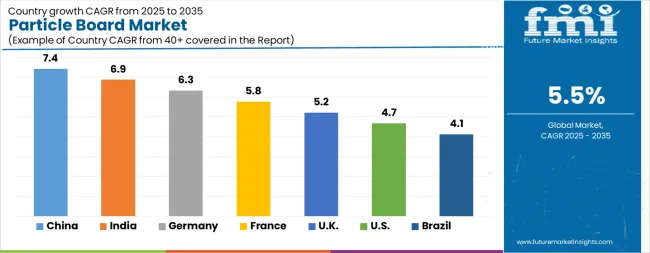
| Country | CAGR |
|---|---|
| China | 7.4% |
| India | 6.9% |
| Germany | 6.3% |
| France | 5.8% |
| UK | 5.2% |
| USA | 4.7% |
| Brazil | 4.1% |
The Particle Board Market is expected to register a CAGR of 5.5% during the forecast period, exhibiting varied country level momentum. China leads with the highest CAGR of 7.4%, followed by India at 6.9%. Developed markets such as Germany, France, and the UK continue to expand steadily, while the USA is likely to grow at consistent rates. Brazil posts the lowest CAGR at 4.1%, yet still underscores a broadly positive trajectory for the global Particle Board Market. In 2024, Germany held a dominant revenue in the Western Europe market and is expected to grow with a CAGR of 6.3%. The USA Particle Board Market is estimated to be valued at USD 9.6 billion in 2025 and is anticipated to reach a valuation of USD 15.2 billion by 2035. Sales are projected to rise at a CAGR of 4.7% over the forecast period between 2025 and 2035. While Japan and South Korea markets are estimated to be valued at USD 1.4 billion and USD 889.1 million respectively in 2025.
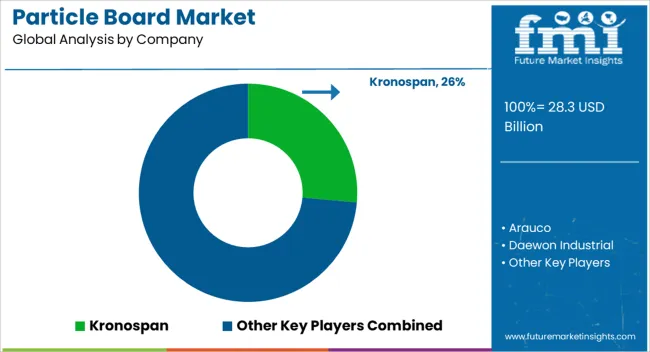
| Item | Value |
|---|---|
| Quantitative Units | USD 28.3 Billion |
| Raw Material | Sawdust, Shavings, Flakes, Excelsior, and Chip |
| Application | Furniture and Construction |
| End Use | Residential, Commercial, and Industrial |
| Regions Covered | North America, Europe, Asia-Pacific, Latin America, Middle East & Africa |
| Country Covered | United States, Canada, Germany, France, United Kingdom, China, Japan, India, Brazil, South Africa |
| Key Companies Profiled | Kronospan, Arauco, Daewon Industrial, Duratex, Egger Group, Finsa, Georgia-Pacific, Homanit, Kastamonu Entegre, Masonite, Nelson Pine, and Pfleiderer |
The global particle board market is estimated to be valued at USD 28.3 billion in 2025.
The market size for the particle board market is projected to reach USD 48.3 billion by 2035.
The particle board market is expected to grow at a 5.5% CAGR between 2025 and 2035.
The key product types in particle board market are sawdust, shavings, flakes, excelsior and chip.
In terms of application, furniture segment to command 53.6% share in the particle board market in 2025.






Our Research Products

The "Full Research Suite" delivers actionable market intel, deep dives on markets or technologies, so clients act faster, cut risk, and unlock growth.

The Leaderboard benchmarks and ranks top vendors, classifying them as Established Leaders, Leading Challengers, or Disruptors & Challengers.

Locates where complements amplify value and substitutes erode it, forecasting net impact by horizon

We deliver granular, decision-grade intel: market sizing, 5-year forecasts, pricing, adoption, usage, revenue, and operational KPIs—plus competitor tracking, regulation, and value chains—across 60 countries broadly.

Spot the shifts before they hit your P&L. We track inflection points, adoption curves, pricing moves, and ecosystem plays to show where demand is heading, why it is changing, and what to do next across high-growth markets and disruptive tech

Real-time reads of user behavior. We track shifting priorities, perceptions of today’s and next-gen services, and provider experience, then pace how fast tech moves from trial to adoption, blending buyer, consumer, and channel inputs with social signals (#WhySwitch, #UX).

Partner with our analyst team to build a custom report designed around your business priorities. From analysing market trends to assessing competitors or crafting bespoke datasets, we tailor insights to your needs.
Supplier Intelligence
Discovery & Profiling
Capacity & Footprint
Performance & Risk
Compliance & Governance
Commercial Readiness
Who Supplies Whom
Scorecards & Shortlists
Playbooks & Docs
Category Intelligence
Definition & Scope
Demand & Use Cases
Cost Drivers
Market Structure
Supply Chain Map
Trade & Policy
Operating Norms
Deliverables
Buyer Intelligence
Account Basics
Spend & Scope
Procurement Model
Vendor Requirements
Terms & Policies
Entry Strategy
Pain Points & Triggers
Outputs
Pricing Analysis
Benchmarks
Trends
Should-Cost
Indexation
Landed Cost
Commercial Terms
Deliverables
Brand Analysis
Positioning & Value Prop
Share & Presence
Customer Evidence
Go-to-Market
Digital & Reputation
Compliance & Trust
KPIs & Gaps
Outputs
Full Research Suite comprises of:
Market outlook & trends analysis
Interviews & case studies
Strategic recommendations
Vendor profiles & capabilities analysis
5-year forecasts
8 regions and 60+ country-level data splits
Market segment data splits
12 months of continuous data updates
DELIVERED AS:
PDF EXCEL ONLINE
Particle Reinforced Aluminum Matrix Composite Brake Disc for Electric Automobiles Market Size and Share Forecast Outlook 2025 to 2035
Particle Foam Molding Machines Market Size and Share Forecast Outlook 2025 to 2035
Particle Counter Market Growth – Trends & Forecast 2018-2028
Particle Size Analyzers Market
Nanoparticle Technology Market Size and Share Forecast Outlook 2025 to 2035
Microparticle Injectables Market
Lipid Nanoparticles Market Insights - Growth & Forecast 2025 to 2035
Silver Nanoparticles Market Size and Share Forecast Outlook 2025 to 2035
Acrylic Fine Particle Market Size and Share Forecast Outlook 2025 to 2035
Platinum Nanoparticles Market
Colloidal Metal Particles Market - Growth & Demand 2025 to 2035
Cerium Oxide Nanoparticle Market Growth – Trends & Forecast 2024-2034
Metal Nitride Nanoparticles Market
Colloidal Selenium Nanoparticles Market Size and Share Forecast Outlook 2025 to 2035
Tungsten Disulphide Nanoparticles Market
Metal & Metal Oxide Nanoparticles Market Growth – Trends & Forecast 2024-2034
Board Games Market Size and Share Forecast Outlook 2025 to 2035
Onboard Marine Gensets Market Size and Share Forecast Outlook 2025 to 2035
Boxboard Packaging Market Analysis - Size, Share, and Forecast Outlook 2025 to 2035
On-Board Connectivity Market Size and Share Forecast Outlook 2025 to 2035

Thank you!
You will receive an email from our Business Development Manager. Please be sure to check your SPAM/JUNK folder too.
Chat With
MaRIA